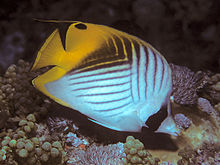Threadfin butterflyfish
| Threadfin butterflyfish | |
|---|---|

| |
| C. a. setifer (Pemba, Tanzania) | |

| |
| C. a. auriga (Sharm el-Sheikh, Red Sea) | |
| Scientific classification | |
| Kingdom: | Animalia |
| Phylum: | Chordata |
| Class: | Actinopterygii |
| Order: | Perciformes |
| Family: | Chaetodontidae |
| Genus: | Chaetodon |
| Subgenus: | Chaetodon (Rabdophorus) |
| Species: | C. auriga
|
| Binomial name | |
| Chaetodon auriga Forsskål, 1775
| |
| Synonyms[2] | |
| |
The threadfin butterflyfish (Chaetodon auriga) is a species of marine ray-finned fish, a butterflyfish belonging to the family Chaetodontidae. It has a wide Indo-Pacific distribution.
Distribution[]
Chaetodon auriga is found in the Indo-Pacific region, from the Red Sea and eastern Africa (south to Mossel Bay, South Africa) to the Hawaiian, Marquesas and Ducie islands, north to southern Japan, south to Lord Howe Island and Rapa Iti, at depths of 1–35 metres (3–115 ft).[2]
Description[]
Chaetodon auriga is up to 23 centimetres (9 in) long. Its body is white with "chevron" markings on the side. Tear edge of the dorsal fin has a prominent black spot, and a prominent black vertical band runs through the eye. The rear of soft-dorsal fin has a trailing filament, and it has a belly patch of descending oblique dark lines as well as bright yellow fins.[3] Two subspecies are sometimes recognised: Chaetodon auriga auriga occurs in the Red Sea population and lacks the dorsal eyespot; Chaetodon auriga setifer is the spotted population occurring outside the Red Sea.[2]
Taxonomy[]
It belongs to the large subgenus Rabdophorus which might warrant recognition as a distinct genus. Within this group, it is almost certainly a rather close relative of the vagabond butterflyfish (C. vagabundus) and the Indian vagabond butterflyfish (C. decussatus). The C. auriga species group shares the characteristic pattern of two areas of ascending and descending oblique lines; species differ conspicuously in hindpart coloration.[4][5]
References[]
- ^ Myers, R.F.; Pratchett, M. (2010). "Chaetodon auriga". IUCN Red List of Threatened Species. 2010: e.T165631A6073721. doi:10.2305/IUCN.UK.2010-4.RLTS.T165631A6073721.en. Retrieved 19 November 2021.
- ^ a b c Froese, Rainer and Pauly, Daniel, eds. (2019). "Chaetodon auriga" in FishBase. December 2019 version.
- ^ Dianne J. Bray. "Chaetodon auriga". Fishes of Australia. Meseums Victoria. Retrieved 13 December 2020.
- ^ Jennifer L. Fessler & Mark W. Westneat (2007). "Molecular phylogenetics of the butterflyfishes (Chaetodontidae): taxonomy and biogeography of a global coral reef fish family". Molecular Phylogenetics and Evolution. 45 (1): 50–68. doi:10.1016/j.ympev.2007.05.018. PMID 17625921.
- ^ Kui-Ching Hsu; Jeng-Ping Chen & Kwang-Tsao Shao (2007). "Molecular phylogeny of Chaetodon (Teleostei: Chaetodontidae) in the Indo-West Pacific: evolution in geminate species pairs and species groups" (PDF). Raffles Bulletin of Zoology. Suppl. 14: 77–86.
External links[]
 Media related to Chaetodon auriga at Wikimedia Commons
Media related to Chaetodon auriga at Wikimedia Commons Data related to Chaetodon auriga at Wikispecies
Data related to Chaetodon auriga at Wikispecies- Photos of Threadfin butterflyfish on Sealife Collection
- IUCN Red List least concern species
- Chaetodon
- Fish of the Pacific Ocean
- Fish of the Red Sea
- Fish of Hawaii
- Fish described in 1775
- Taxa named by Peter Forsskål
